Soliel Panel Distribution Case Study: IS Development and Management
VerifiedAdded on 2022/10/19
|6
|1591
|10
Case Study
AI Summary
The Soliel Panel Distribution case study examines the implementation of an Information System (IS) to enhance operational efficiency. The analysis covers leveraging IS solutions, business process management (BPM), and the selection of the waterfall model for system development, detailing its advantages and limitations. The case study addresses IS security, including potential threats and mitigation strategies, such as strong passwords and surveillance. Furthermore, it explores incident management, troubleshooting, and the importance of problem management to prevent disasters and improve system reliability, including reactive and proactive approaches. The document also outlines the key contributors to the project, including management, employees, software developers, suppliers, and customers and the roles they play in the success of the project.
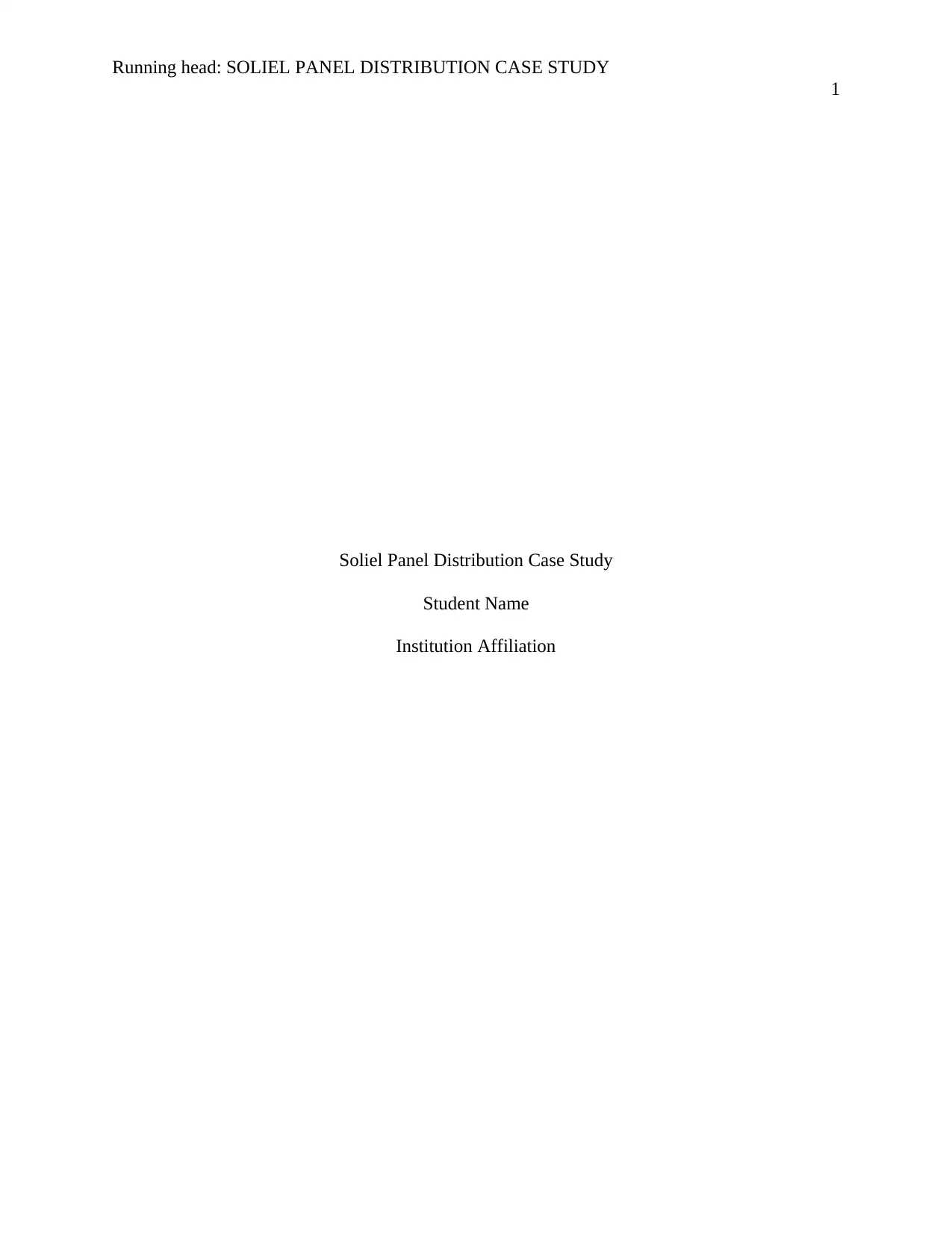
Running head: SOLIEL PANEL DISTRIBUTION CASE STUDY
1
Soliel Panel Distribution Case Study
Student Name
Institution Affiliation
1
Soliel Panel Distribution Case Study
Student Name
Institution Affiliation
Paraphrase This Document
Need a fresh take? Get an instant paraphrase of this document with our AI Paraphraser
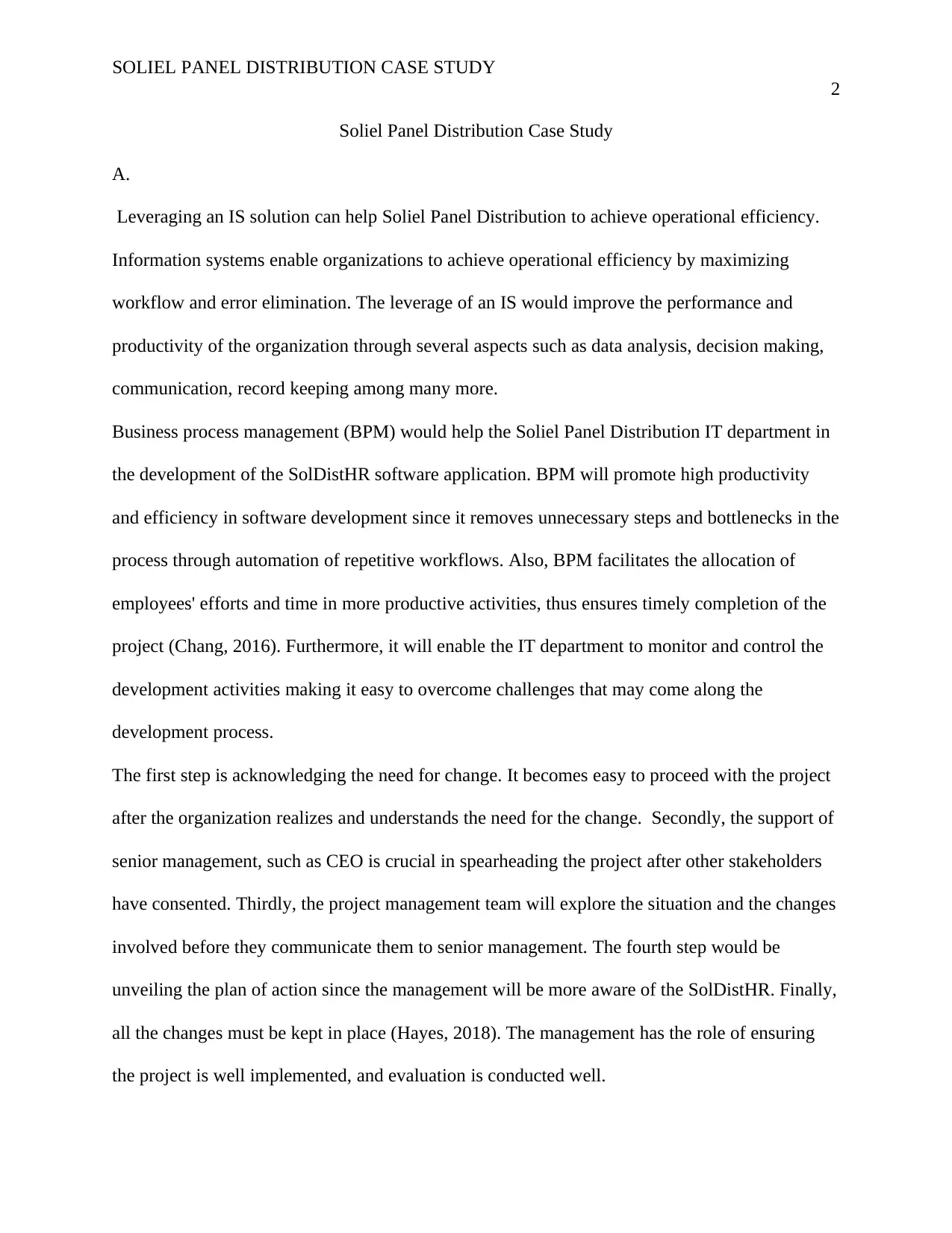
SOLIEL PANEL DISTRIBUTION CASE STUDY
2
Soliel Panel Distribution Case Study
A.
Leveraging an IS solution can help Soliel Panel Distribution to achieve operational efficiency.
Information systems enable organizations to achieve operational efficiency by maximizing
workflow and error elimination. The leverage of an IS would improve the performance and
productivity of the organization through several aspects such as data analysis, decision making,
communication, record keeping among many more.
Business process management (BPM) would help the Soliel Panel Distribution IT department in
the development of the SolDistHR software application. BPM will promote high productivity
and efficiency in software development since it removes unnecessary steps and bottlenecks in the
process through automation of repetitive workflows. Also, BPM facilitates the allocation of
employees' efforts and time in more productive activities, thus ensures timely completion of the
project (Chang, 2016). Furthermore, it will enable the IT department to monitor and control the
development activities making it easy to overcome challenges that may come along the
development process.
The first step is acknowledging the need for change. It becomes easy to proceed with the project
after the organization realizes and understands the need for the change. Secondly, the support of
senior management, such as CEO is crucial in spearheading the project after other stakeholders
have consented. Thirdly, the project management team will explore the situation and the changes
involved before they communicate them to senior management. The fourth step would be
unveiling the plan of action since the management will be more aware of the SolDistHR. Finally,
all the changes must be kept in place (Hayes, 2018). The management has the role of ensuring
the project is well implemented, and evaluation is conducted well.
2
Soliel Panel Distribution Case Study
A.
Leveraging an IS solution can help Soliel Panel Distribution to achieve operational efficiency.
Information systems enable organizations to achieve operational efficiency by maximizing
workflow and error elimination. The leverage of an IS would improve the performance and
productivity of the organization through several aspects such as data analysis, decision making,
communication, record keeping among many more.
Business process management (BPM) would help the Soliel Panel Distribution IT department in
the development of the SolDistHR software application. BPM will promote high productivity
and efficiency in software development since it removes unnecessary steps and bottlenecks in the
process through automation of repetitive workflows. Also, BPM facilitates the allocation of
employees' efforts and time in more productive activities, thus ensures timely completion of the
project (Chang, 2016). Furthermore, it will enable the IT department to monitor and control the
development activities making it easy to overcome challenges that may come along the
development process.
The first step is acknowledging the need for change. It becomes easy to proceed with the project
after the organization realizes and understands the need for the change. Secondly, the support of
senior management, such as CEO is crucial in spearheading the project after other stakeholders
have consented. Thirdly, the project management team will explore the situation and the changes
involved before they communicate them to senior management. The fourth step would be
unveiling the plan of action since the management will be more aware of the SolDistHR. Finally,
all the changes must be kept in place (Hayes, 2018). The management has the role of ensuring
the project is well implemented, and evaluation is conducted well.
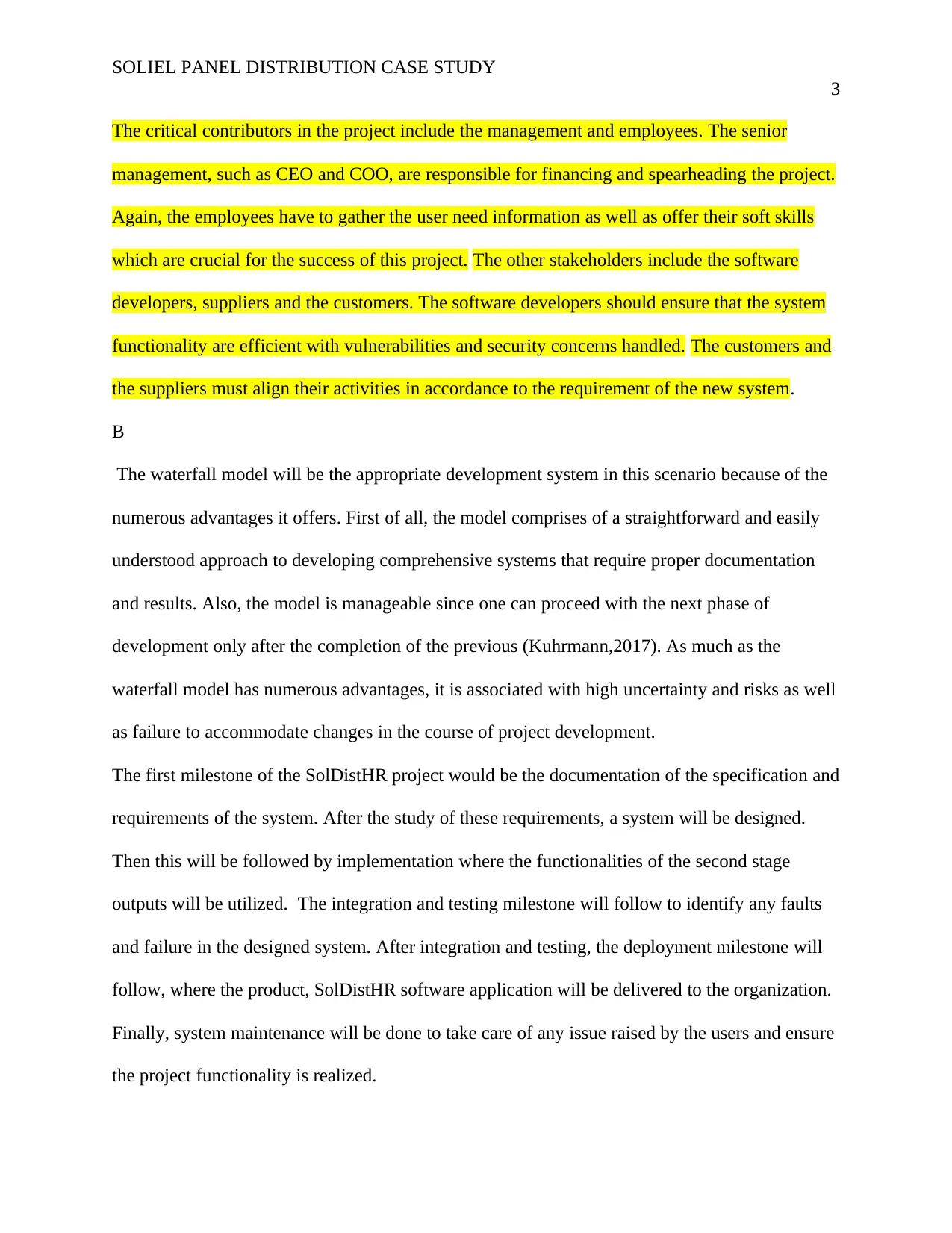
SOLIEL PANEL DISTRIBUTION CASE STUDY
3
The critical contributors in the project include the management and employees. The senior
management, such as CEO and COO, are responsible for financing and spearheading the project.
Again, the employees have to gather the user need information as well as offer their soft skills
which are crucial for the success of this project. The other stakeholders include the software
developers, suppliers and the customers. The software developers should ensure that the system
functionality are efficient with vulnerabilities and security concerns handled. The customers and
the suppliers must align their activities in accordance to the requirement of the new system.
B
The waterfall model will be the appropriate development system in this scenario because of the
numerous advantages it offers. First of all, the model comprises of a straightforward and easily
understood approach to developing comprehensive systems that require proper documentation
and results. Also, the model is manageable since one can proceed with the next phase of
development only after the completion of the previous (Kuhrmann,2017). As much as the
waterfall model has numerous advantages, it is associated with high uncertainty and risks as well
as failure to accommodate changes in the course of project development.
The first milestone of the SolDistHR project would be the documentation of the specification and
requirements of the system. After the study of these requirements, a system will be designed.
Then this will be followed by implementation where the functionalities of the second stage
outputs will be utilized. The integration and testing milestone will follow to identify any faults
and failure in the designed system. After integration and testing, the deployment milestone will
follow, where the product, SolDistHR software application will be delivered to the organization.
Finally, system maintenance will be done to take care of any issue raised by the users and ensure
the project functionality is realized.
3
The critical contributors in the project include the management and employees. The senior
management, such as CEO and COO, are responsible for financing and spearheading the project.
Again, the employees have to gather the user need information as well as offer their soft skills
which are crucial for the success of this project. The other stakeholders include the software
developers, suppliers and the customers. The software developers should ensure that the system
functionality are efficient with vulnerabilities and security concerns handled. The customers and
the suppliers must align their activities in accordance to the requirement of the new system.
B
The waterfall model will be the appropriate development system in this scenario because of the
numerous advantages it offers. First of all, the model comprises of a straightforward and easily
understood approach to developing comprehensive systems that require proper documentation
and results. Also, the model is manageable since one can proceed with the next phase of
development only after the completion of the previous (Kuhrmann,2017). As much as the
waterfall model has numerous advantages, it is associated with high uncertainty and risks as well
as failure to accommodate changes in the course of project development.
The first milestone of the SolDistHR project would be the documentation of the specification and
requirements of the system. After the study of these requirements, a system will be designed.
Then this will be followed by implementation where the functionalities of the second stage
outputs will be utilized. The integration and testing milestone will follow to identify any faults
and failure in the designed system. After integration and testing, the deployment milestone will
follow, where the product, SolDistHR software application will be delivered to the organization.
Finally, system maintenance will be done to take care of any issue raised by the users and ensure
the project functionality is realized.
⊘ This is a preview!⊘
Do you want full access?
Subscribe today to unlock all pages.

Trusted by 1+ million students worldwide
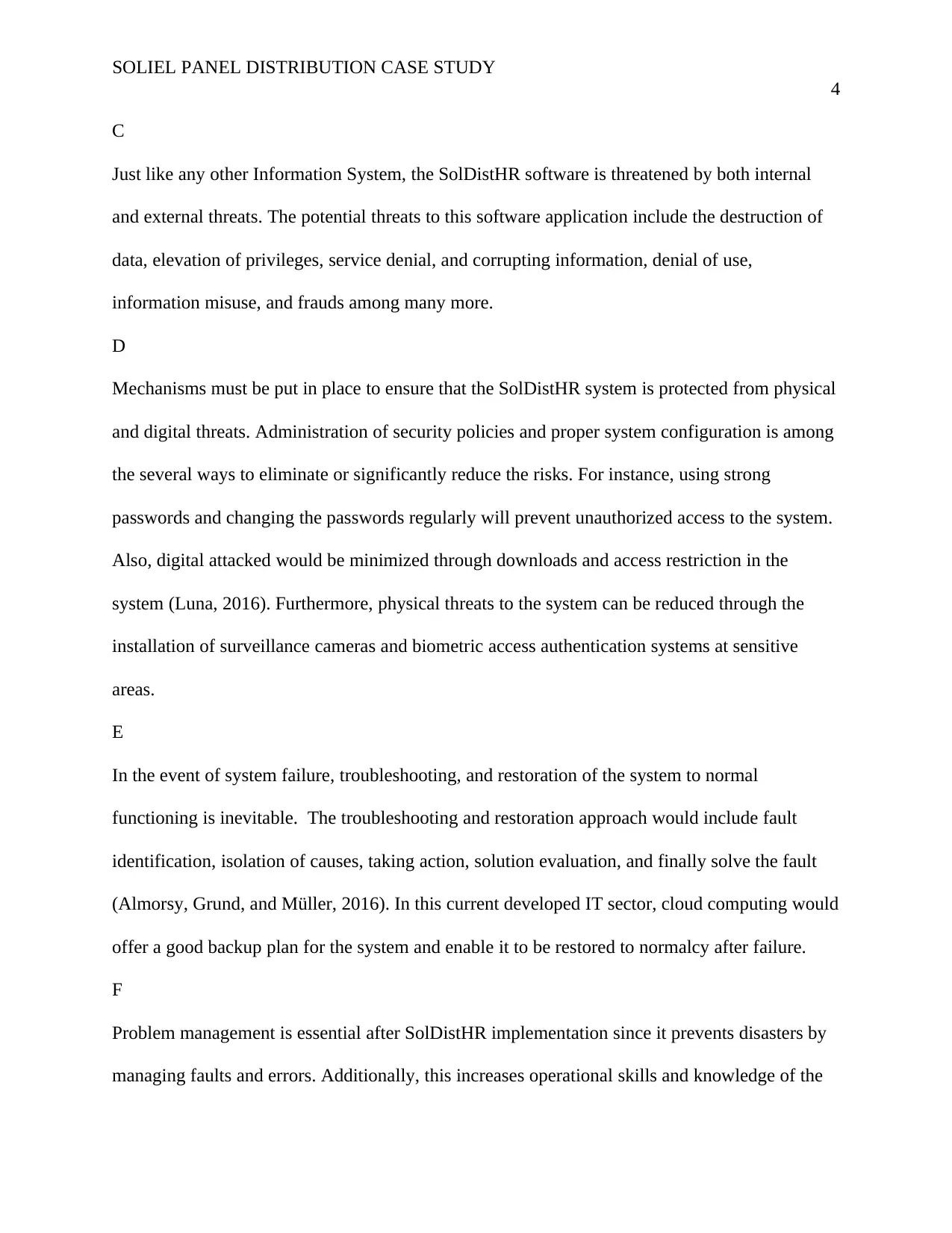
SOLIEL PANEL DISTRIBUTION CASE STUDY
4
C
Just like any other Information System, the SolDistHR software is threatened by both internal
and external threats. The potential threats to this software application include the destruction of
data, elevation of privileges, service denial, and corrupting information, denial of use,
information misuse, and frauds among many more.
D
Mechanisms must be put in place to ensure that the SolDistHR system is protected from physical
and digital threats. Administration of security policies and proper system configuration is among
the several ways to eliminate or significantly reduce the risks. For instance, using strong
passwords and changing the passwords regularly will prevent unauthorized access to the system.
Also, digital attacked would be minimized through downloads and access restriction in the
system (Luna, 2016). Furthermore, physical threats to the system can be reduced through the
installation of surveillance cameras and biometric access authentication systems at sensitive
areas.
E
In the event of system failure, troubleshooting, and restoration of the system to normal
functioning is inevitable. The troubleshooting and restoration approach would include fault
identification, isolation of causes, taking action, solution evaluation, and finally solve the fault
(Almorsy, Grund, and Müller, 2016). In this current developed IT sector, cloud computing would
offer a good backup plan for the system and enable it to be restored to normalcy after failure.
F
Problem management is essential after SolDistHR implementation since it prevents disasters by
managing faults and errors. Additionally, this increases operational skills and knowledge of the
4
C
Just like any other Information System, the SolDistHR software is threatened by both internal
and external threats. The potential threats to this software application include the destruction of
data, elevation of privileges, service denial, and corrupting information, denial of use,
information misuse, and frauds among many more.
D
Mechanisms must be put in place to ensure that the SolDistHR system is protected from physical
and digital threats. Administration of security policies and proper system configuration is among
the several ways to eliminate or significantly reduce the risks. For instance, using strong
passwords and changing the passwords regularly will prevent unauthorized access to the system.
Also, digital attacked would be minimized through downloads and access restriction in the
system (Luna, 2016). Furthermore, physical threats to the system can be reduced through the
installation of surveillance cameras and biometric access authentication systems at sensitive
areas.
E
In the event of system failure, troubleshooting, and restoration of the system to normal
functioning is inevitable. The troubleshooting and restoration approach would include fault
identification, isolation of causes, taking action, solution evaluation, and finally solve the fault
(Almorsy, Grund, and Müller, 2016). In this current developed IT sector, cloud computing would
offer a good backup plan for the system and enable it to be restored to normalcy after failure.
F
Problem management is essential after SolDistHR implementation since it prevents disasters by
managing faults and errors. Additionally, this increases operational skills and knowledge of the
Paraphrase This Document
Need a fresh take? Get an instant paraphrase of this document with our AI Paraphraser
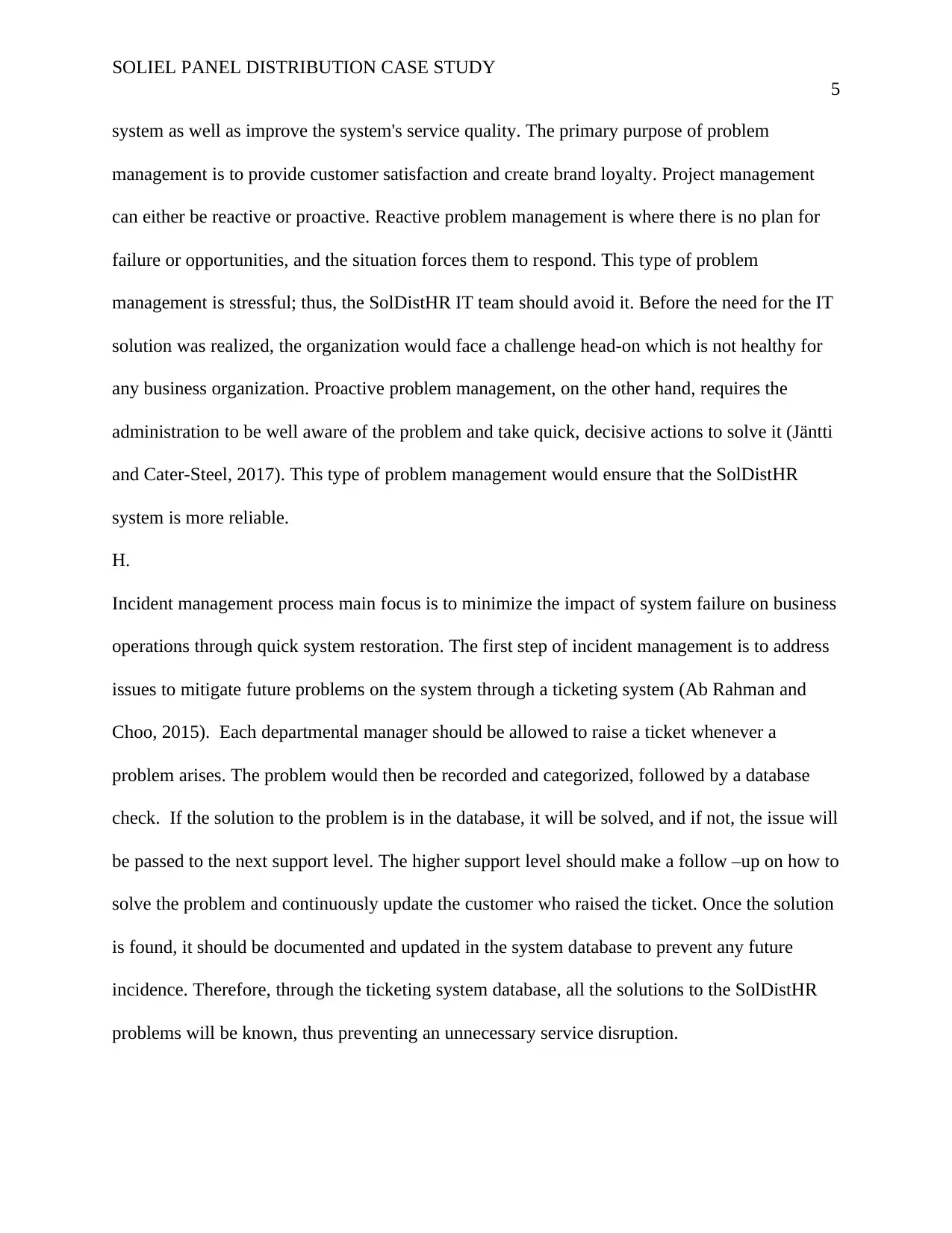
SOLIEL PANEL DISTRIBUTION CASE STUDY
5
system as well as improve the system's service quality. The primary purpose of problem
management is to provide customer satisfaction and create brand loyalty. Project management
can either be reactive or proactive. Reactive problem management is where there is no plan for
failure or opportunities, and the situation forces them to respond. This type of problem
management is stressful; thus, the SolDistHR IT team should avoid it. Before the need for the IT
solution was realized, the organization would face a challenge head-on which is not healthy for
any business organization. Proactive problem management, on the other hand, requires the
administration to be well aware of the problem and take quick, decisive actions to solve it (Jäntti
and Cater-Steel, 2017). This type of problem management would ensure that the SolDistHR
system is more reliable.
H.
Incident management process main focus is to minimize the impact of system failure on business
operations through quick system restoration. The first step of incident management is to address
issues to mitigate future problems on the system through a ticketing system (Ab Rahman and
Choo, 2015). Each departmental manager should be allowed to raise a ticket whenever a
problem arises. The problem would then be recorded and categorized, followed by a database
check. If the solution to the problem is in the database, it will be solved, and if not, the issue will
be passed to the next support level. The higher support level should make a follow –up on how to
solve the problem and continuously update the customer who raised the ticket. Once the solution
is found, it should be documented and updated in the system database to prevent any future
incidence. Therefore, through the ticketing system database, all the solutions to the SolDistHR
problems will be known, thus preventing an unnecessary service disruption.
5
system as well as improve the system's service quality. The primary purpose of problem
management is to provide customer satisfaction and create brand loyalty. Project management
can either be reactive or proactive. Reactive problem management is where there is no plan for
failure or opportunities, and the situation forces them to respond. This type of problem
management is stressful; thus, the SolDistHR IT team should avoid it. Before the need for the IT
solution was realized, the organization would face a challenge head-on which is not healthy for
any business organization. Proactive problem management, on the other hand, requires the
administration to be well aware of the problem and take quick, decisive actions to solve it (Jäntti
and Cater-Steel, 2017). This type of problem management would ensure that the SolDistHR
system is more reliable.
H.
Incident management process main focus is to minimize the impact of system failure on business
operations through quick system restoration. The first step of incident management is to address
issues to mitigate future problems on the system through a ticketing system (Ab Rahman and
Choo, 2015). Each departmental manager should be allowed to raise a ticket whenever a
problem arises. The problem would then be recorded and categorized, followed by a database
check. If the solution to the problem is in the database, it will be solved, and if not, the issue will
be passed to the next support level. The higher support level should make a follow –up on how to
solve the problem and continuously update the customer who raised the ticket. Once the solution
is found, it should be documented and updated in the system database to prevent any future
incidence. Therefore, through the ticketing system database, all the solutions to the SolDistHR
problems will be known, thus preventing an unnecessary service disruption.
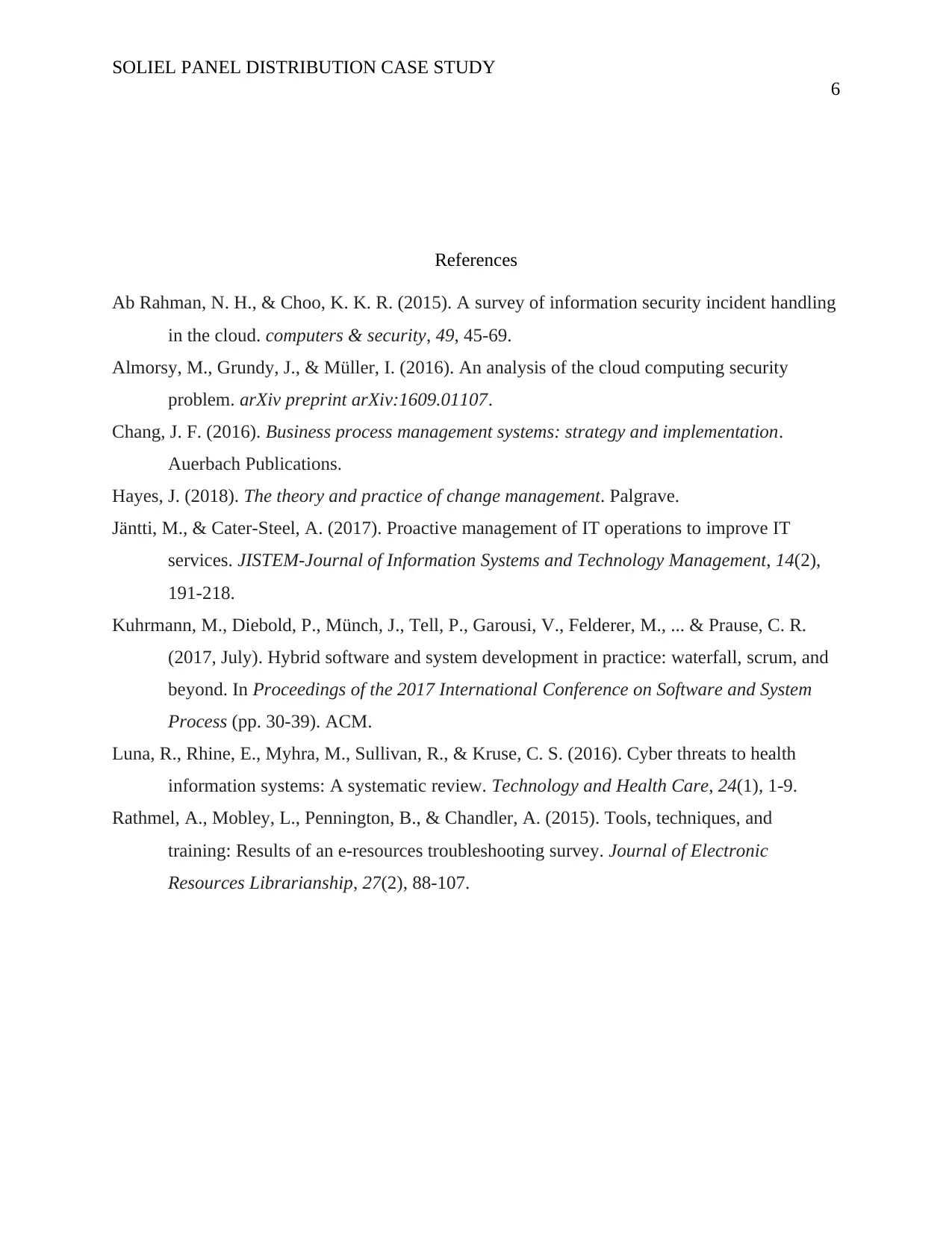
SOLIEL PANEL DISTRIBUTION CASE STUDY
6
References
Ab Rahman, N. H., & Choo, K. K. R. (2015). A survey of information security incident handling
in the cloud. computers & security, 49, 45-69.
Almorsy, M., Grundy, J., & Müller, I. (2016). An analysis of the cloud computing security
problem. arXiv preprint arXiv:1609.01107.
Chang, J. F. (2016). Business process management systems: strategy and implementation.
Auerbach Publications.
Hayes, J. (2018). The theory and practice of change management. Palgrave.
Jäntti, M., & Cater-Steel, A. (2017). Proactive management of IT operations to improve IT
services. JISTEM-Journal of Information Systems and Technology Management, 14(2),
191-218.
Kuhrmann, M., Diebold, P., Münch, J., Tell, P., Garousi, V., Felderer, M., ... & Prause, C. R.
(2017, July). Hybrid software and system development in practice: waterfall, scrum, and
beyond. In Proceedings of the 2017 International Conference on Software and System
Process (pp. 30-39). ACM.
Luna, R., Rhine, E., Myhra, M., Sullivan, R., & Kruse, C. S. (2016). Cyber threats to health
information systems: A systematic review. Technology and Health Care, 24(1), 1-9.
Rathmel, A., Mobley, L., Pennington, B., & Chandler, A. (2015). Tools, techniques, and
training: Results of an e-resources troubleshooting survey. Journal of Electronic
Resources Librarianship, 27(2), 88-107.
6
References
Ab Rahman, N. H., & Choo, K. K. R. (2015). A survey of information security incident handling
in the cloud. computers & security, 49, 45-69.
Almorsy, M., Grundy, J., & Müller, I. (2016). An analysis of the cloud computing security
problem. arXiv preprint arXiv:1609.01107.
Chang, J. F. (2016). Business process management systems: strategy and implementation.
Auerbach Publications.
Hayes, J. (2018). The theory and practice of change management. Palgrave.
Jäntti, M., & Cater-Steel, A. (2017). Proactive management of IT operations to improve IT
services. JISTEM-Journal of Information Systems and Technology Management, 14(2),
191-218.
Kuhrmann, M., Diebold, P., Münch, J., Tell, P., Garousi, V., Felderer, M., ... & Prause, C. R.
(2017, July). Hybrid software and system development in practice: waterfall, scrum, and
beyond. In Proceedings of the 2017 International Conference on Software and System
Process (pp. 30-39). ACM.
Luna, R., Rhine, E., Myhra, M., Sullivan, R., & Kruse, C. S. (2016). Cyber threats to health
information systems: A systematic review. Technology and Health Care, 24(1), 1-9.
Rathmel, A., Mobley, L., Pennington, B., & Chandler, A. (2015). Tools, techniques, and
training: Results of an e-resources troubleshooting survey. Journal of Electronic
Resources Librarianship, 27(2), 88-107.
⊘ This is a preview!⊘
Do you want full access?
Subscribe today to unlock all pages.

Trusted by 1+ million students worldwide
1 out of 6
Related Documents
Your All-in-One AI-Powered Toolkit for Academic Success.
+13062052269
info@desklib.com
Available 24*7 on WhatsApp / Email
![[object Object]](/_next/static/media/star-bottom.7253800d.svg)
Unlock your academic potential
Copyright © 2020–2025 A2Z Services. All Rights Reserved. Developed and managed by ZUCOL.





